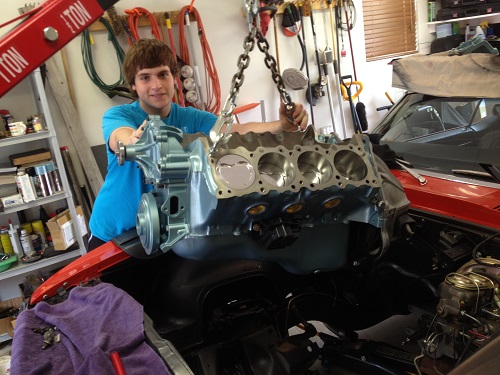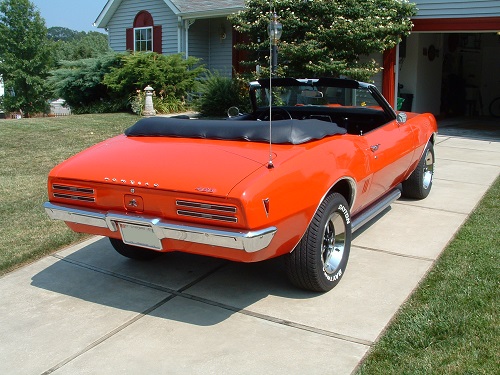For Fan Car Friday this week we bring you another Pontiac, this time a Firebird Convertible brought to us by Alan. Fan Car Friday is a segment where we want to share with the world the automobiles that our fans have. We have absolutely no affiliation/relationship with the cars, the build or the owners. This post was made with written consent from the owner.

Alan’s first car was a the 67 Firebird Convertible, that is shown below, that he purchased for $1200 in 1980. That one came with a straight 6 and a 2 speed automatic transmission. “Everything was faster than it but it looked so good. It lasted 13 months before I totaled it.” Always missing that first car Alan decided to buy one with all the options once he finally had the funds to replace his first car. He chose the 1968 version for the lit arrow side marker lights being a bit cooler in style and minus the wing windows. This new Firebird is a PHS documented real 400 HO 4 speed car with the Ram Air 3 Engine and camshaft but no hood openings. Having the paint code of R2, or Red exterior and black top. It has all the power comforts such as Power Brakes, Power Top and Power Steering. Purchasing the new one in 2007 as a project car he has collected some great memories but “the best are all those Saturdays spent in the garage taking it apart and putting it back together. Knowing that except for paint, rebuilding the trans and differential that I did it all myself.”

Here are a few other fond memories from Alan with his Firebird:
“One fond memory is when I was “cruising alongside” a 2000 Trans Am and we saw red lights way behind us. We pulled over and the officer thanked me for pulling over saying he never would of caught me. No ticket just a warning.
Another good story is when my son did a burnout in his Challenger SRT8 and I did one after him. He said he couldn’t believe mine was 10’ longer LOL.”
So thank you to Alan for sharing his memories and passing on the tradition of loving a good muscle car.

The Pontiac Firebird is an American automobile built by Pontiac from the 1967 to the 2002 model years. Designed as a pony car to compete with the Ford Mustang, it was introduced February 23, 1967, the same model year as GM’s Chevrolet division platform-sharing Camaro. This also coincided with the release of the 1967 Mercury Cougar, Ford’s upscale, platform-sharing version of the Mustang.
The first generation Firebird had characteristic Coke bottle styling shared with its cousin, the Chevrolet Camaro. Announcing a Pontiac styling trend, the Firebird’s bumpers were integrated into the design of the front end, giving it a more streamlined look than the Camaro. The Firebird’s rear “slit” taillights were inspired by the 1966–1967 Pontiac GTO. Both a two-door hardtop and a convertible were offered through the 1969 model year. Originally, the car was a “consolation prize” for Pontiac, which had desired to produce a two-seat sports car based on its original Banshee concept car. However, GM feared this would cut into Chevrolet Corvette sales, and gave Pontiac a piece of the “pony car” market through sharing the F-body platform with Chevrolet.
The 1967 base model Firebird came equipped with the Pontiac 230 cu in (3.8 L) SOHC inline-six. Based on the standard Chevrolet 230 cu in (3.8 L) inline-six, it was fitted with a single-barrel carburetor and rated at 165 hp (123 kW). The “Sprint” model six came with a four-barrel carburetor, developing 215 hp (160 kW).[6] Most buyers opted for one of three V8s: the 326 cu in (5.3 L) with a two-barrel carburetor producing 250 hp (190 kW); the four-barrel “HO” (high output) 326, producing 285 hp (213 kW); or the 325 hp (242 kW) 400 cu in (6.6 L) from the GTO. All 1967–1968 400 CI engines had throttle restrictors that blocked the carburetors’ second barrels from fully opening. A “Ram Air” option was also available, providing functional hood scoops, higher flow heads with stronger valve springs, and a hotter camshaft. Power for the Ram Air package was the same as the conventional 400 HO, but peaked at 5,200 RPM.
The 230 cu in (3.8 L) engines were subsequently replaced in 1968 by the Chevrolet 250 cu in (4.1 L) stroked 230 cu in (3.8 L) engines, the first developing an increased 175 hp (130 kW) using a single-barrel carburetor, and the other the same 215hp with a four-barrel carburetor. Also for the 1968 model, the 326 cu in (5.3 L) engine was replaced by the Pontiac 350 cu in (5.7 L) V8, which actually displaced 355 cu in (5.8 L), and produced 265 hp (198 kW) with a two-barrel carburetor. An HO version of the 350 cu in (5.7 L) with a revised cam was also offered starting in that year, which developed 320 hp (240 kW). Power output of the other engines was increased marginally.
There was an additional Ram Air IV option for the 400 cu in (6.6 L) V8 engines during 1969, complementing the Ram Air III; these generated 345 hp (350 PS; 257 kW) at 5000 rpm and 430 lb·ft (583 N·m) of torque at 3400 rpm; and 335 hp (340 PS; 250 kW) respectively. The 350 cu in (5.7 L) HO engine was revised again with a different cam and cylinder heads resulting in 325 hp (242 kW). During 1969 a special 303 cu in (5.0 L) engine was designed for SCCA road racing applications that was not available in production cars.
The styling difference from the 1967 to the 1968 model was the addition of federally-mandated side marker lights: for the front of the car, the turn signals were made larger and extended to wrap around the front edges of the car, and on the rear, the Pontiac (V-shaped) Arrowhead logo was added to each side. The front door vent-windows were replaced with a single pane of glass and Astro Ventilation, a fresh-air-inlet system. The 1969 model received a major facelift with a new front end design but unlike the GTO, it did not have the Endura bumper. The instrument panel and steering wheel were revised. The ignition switch was moved from the dashboard to the steering column with the introduction of GM’s new locking ignition switch/steering wheel.
https://en.wikipedia.org/wiki/Pontiac_Firebird

Want your car to be featured as one of our Fan Car Friday’s post? Know somebody that might? Use the contact link at the bottom and email us a couple of photos as well as your contact information and your vehicle could be featured on an upcoming Friday post. Please make sure to put FAN CAR in the subject heading.
Another GM beauty
Another timeless classic from GM
nice.